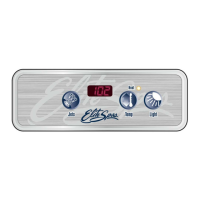39
Common Water Problems (continued)
Problem Cause Solution
Eye Irritation •Low pH •Raise pH with sodium bicarbonate
product.
•Insufficient free available chlorine •Shock with a chlorine sanitizer/shock or
other shock treatment product.
Skin Irritation/ •Unsanitary/polluted water •Keep recommended sanitizer residual at
Rash all times; superchlorinate or use a non-
chlorine shock treatment.
•Soaking too long •Soak for smaller intervals, such as 15
minutes.
•Chemicals not balanced, •Correct chemical imbalance.
excessive ozone
Scale •Too much calcium dissolved in water •Add a scale control product. Adjust total
pH and total alkalinity too high alkalinity and pH levels by adding the
appropriate sodium bisulfate product; for
concentrated scale deposits - drain spa,
scrub the scale off, refill the spa and
balance the water.
Erratic pH Test •Sanitizer level too high •Test the pH, when the sanitizer level is
Results/Unusual below 5 ppm.
pH Test Color •Old pH indicator dye •Replace the pH indicator dye.
Sanitizer •Excessive organics in water •Increase shock dosage; add sanitizer;
Dissipating shower before entering spa.
Too Rapidly •Temperature too high •Reduce temperature.
•Low pH •Raise pH with sodium bicarbonate
product.
•Low pH Corrosion of Metal Fixtures •Use chelating agent if metals are present.
Keep proper pH level (7.2 to 7.6).
•Low calcium hardness •Use chelating agent if metals are present.
Maintain minimum 150-200 ppm calcium
hardness.
•Low total alkalinity •Use chelating agent if metals are present.
Maintain proper alkalinity for type of
sanitizer used
Note: If your source water has a high metal or mineral content, a specialty chemical should be used to avoid staining
or accumulation of deposits.
These guidelines cover the most common water problems when operating a spa with ozone. Contact your dealer for
further information regarding chemical control issues.

